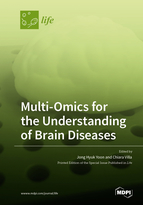Multi-Omics for the Understanding of Brain Diseases
A special issue of Life (ISSN 2075-1729). This special issue belongs to the section "Proteins and Proteomics".
Deadline for manuscript submissions: closed (25 August 2021) | Viewed by 45189
Special Issue Editors
Interests: neurodegenerative disease; proteomics; multi-omics; biochemistry; bioinformatics
Interests: genetics; Alzheimer’s disease; non-coding RNAs; neurodegeneration; epilepsy; brain; biomarkers
Special Issues, Collections and Topics in MDPI journals
Special Issue Information
Dear Colleagues,
Omics technologies such as proteomics, genomics, and metabolomics are widely applied for the identification and characterization of new molecular signatures. However, molecular profiling that makes it possible to understand neurodegenerative diseases has been relatively insufficient. Brain diseases such as neurodegenerative diseases and emotional disorders need integrative understanding which draws a more reliable hypothesis for pathology, which can be accomplished via an in-depth study of molecular information. Recently, multi-omics technologies have been eagerly applied to diverse diseases. Because this includes multiple molecular profiling, metadata, and big data processing with informatics and computer science, it is possible to provide new macroscopic as well as microscopic insight to understand diseases. This issue will introduce recent technological advances of multi-omics and the application of omics technology to brain diseases.
Dr. Jong Yoon
Dr. Chiara Villa
Guest Editors
Manuscript Submission Information
Manuscripts should be submitted online at www.mdpi.com by registering and logging in to this website. Once you are registered, click here to go to the submission form. Manuscripts can be submitted until the deadline. All submissions that pass pre-check are peer-reviewed. Accepted papers will be published continuously in the journal (as soon as accepted) and will be listed together on the special issue website. Research articles, review articles as well as short communications are invited. For planned papers, a title and short abstract (about 100 words) can be sent to the Editorial Office for announcement on this website.
Submitted manuscripts should not have been published previously, nor be under consideration for publication elsewhere (except conference proceedings papers). All manuscripts are thoroughly refereed through a single-blind peer-review process. A guide for authors and other relevant information for submission of manuscripts is available on the Instructions for Authors page. Life is an international peer-reviewed open access monthly journal published by MDPI.
Please visit the Instructions for Authors page before submitting a manuscript. The Article Processing Charge (APC) for publication in this open access journal is 2600 CHF (Swiss Francs). Submitted papers should be well formatted and use good English. Authors may use MDPI's English editing service prior to publication or during author revisions.
Keywords
- Multi-omics Neurodegenerative diseases
- Proteomics
- Metabolomics
- Genomics
- Lipidomics
- Alzheimer’s disease








